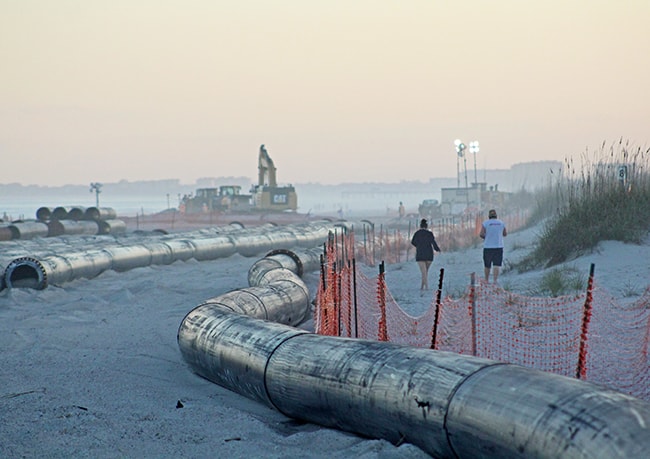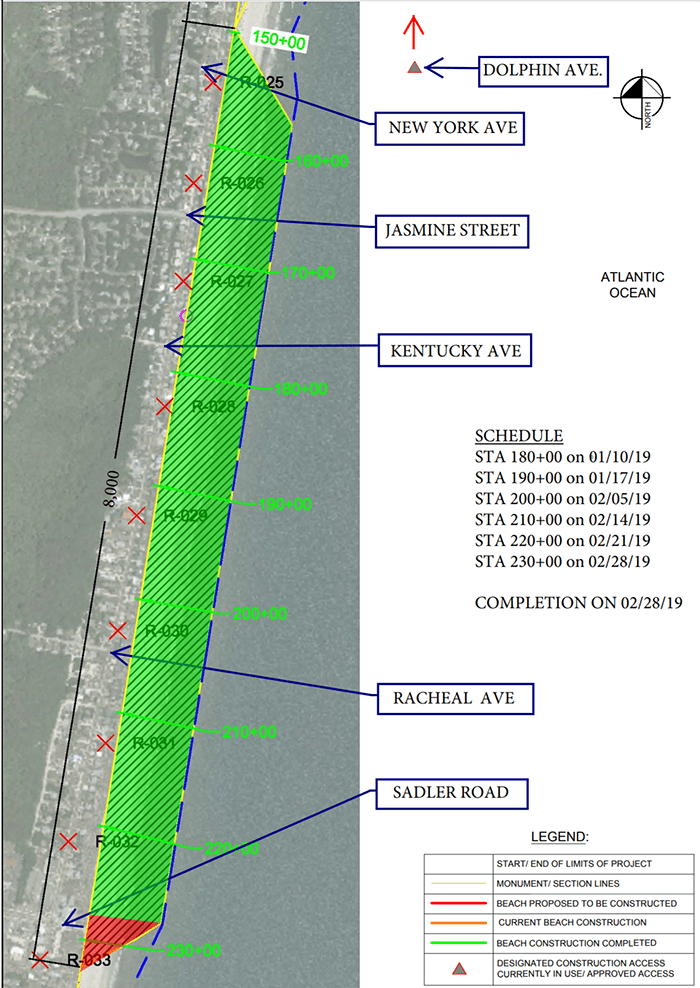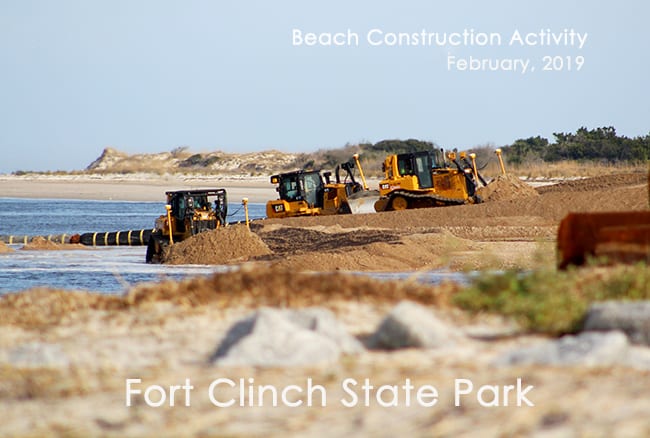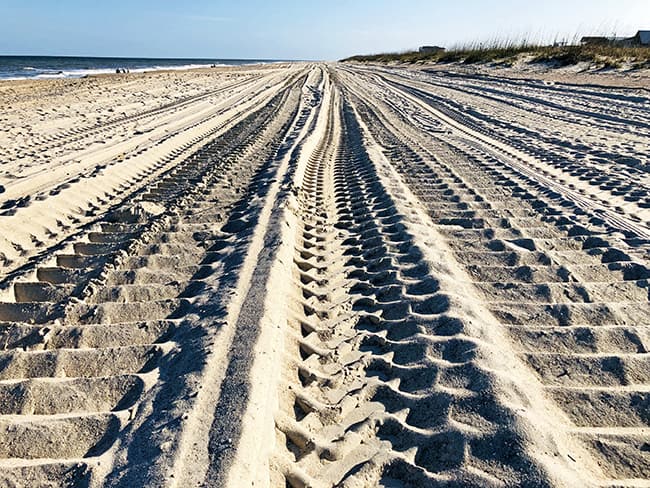
“Beach nourishment” is a coastal management tool implemented on Amelia Island and elsewhere in coastal communities. The most recent sand placement in Fernandina Beach during winter of 2018/2019 is nearing completion. The latest city project update indicates the process should be wrapped up by March 22, 2019.

The dredging of the St. Mary’s river entrance channel and associated distribution of sand on Fernandina’s beachfront is a U.S. Army Corps of Engineers operation (Jacksonville division). For new residents and first time visitors to the Amelia Island area who may be unfamiliar with this region, the nearby Naval Base at Kings Bay, Georgia is home to Ohio-class ballistic-missile submarines. Here at the Florida-Georgia border, the channel dredging is described as “critical to commercial cargo transiting the Fernandina port and also to the Kings Bay, GA Navy base, which share the St. Mary’s entrance channel,” according to the Army Corps.
Mobilizing Equipment
Dredging deepens the channel and helps to nourish the beachfront. The process requires an enormous effort that includes the logistics of multiple vessels including hopper dredgers, plus extensive lengths of pipe and heavy equipment on the beach such as excavators and bulldozers. Hopper dredgers are used to excavate and collect sand in the inlet, then transport it from off shore to the beach. Once the sand pumping operation is completed, the process of equipment demobilization takes several weeks.

Watch the video further below taken on site with the sand/water mixture spewing onto the beach. The video includes more info about the Fernandina Beach nourishment project and insight on steps taken to protect Amelia Island’s sea turtles during dredging operations.

Besides the area of Fernandina Beach depicted in the map above, beach construction activities have also been underway at Fort Clinch State Park’s eastern inlet area (the island’s north end) and Amelia Island State Park (the island’s southern tip). Further details about the project at Amelia Island State Park is at end of article.

Trident Submarines
As noted above, the strategic marine channel off the north end of Amelia Island is a key waterway shared with the U.S. Navy, its Trident nuclear powered submarines passing by Fernandina’s Fort Clinch on their way in and out of the nearby Kings Bay, GA base.

Scope of Operation
The breadth of the dredging and sand placement process is apparent. One need only be on location at this year’s three project sites to glimpse the scope of the operation, both on land and in the water, with multiple vessels off shore. Lots of sand gets pushed around and heavy machinery moves along the beachfront. You can also hear the sand/water mixture moving through the pipeline at times, when in close proximity. The public can still access the majority of Amelia Island’s beachfront during the nourishment process. The exception is the exact sites of active work areas that are barricaded off temporarily, as equipment moves along the beach during the process.

Project Costs Nearly $33 Million
Back in November 2017 when the U.S. Army Corp of Engineers announced the project, the cost was indicated at $32,859,630 (contract awarded to the Dutra Group, read the news here). Some of the work was completed last year in the beginning of 2018 (a segment of the city’s beachfront between New York Avenue and Jasmine Street). The remainder had to wait another year since dredging and nourishment projects cease during sea turtle nesting season. Fernandina Beach, Nassau County, and the Florida Department of Environmental Protection contributed $1.6 million to the project.
Featured in the video interview below is Fernandina Beach city commissioner and Vice-Mayor, Len Kreger. He notes that this Fernandina Beach project is “probably the best in the United States as far as local share.” The Amelia Island Tourist Development Council (TDC), the source of this video, contributes to nourishment (from their “beach improvement fund”), and also pays for cleaning the beachfront. The process of keeping the beaches clean has been under review, and changes are anticipated for summer 2019.
Impact of Jetties
Long ago, around the 1880s, the jetties were constructed at the St. Marys Inlet for navigation of the channel into the Fernandina Port. The man-made jetties interfere with the natural flow of sand south to Amelia Island. There are approximately “three miles of jetties along the north and south sides of entrance to the St. Marys River,” according to Degrove Surveyors who have surveyed the jetties for the U.S. Army Corp of Engineers.
The Florida Dept. of Environmental Protection’s website indicates the following: “A significant amount of coastal erosion in Florida is directly attributable to the construction and maintenance of navigation inlets. Many have been artificially deepened to accommodate commercial and recreational vessels and employ jetties to prevent sand from filling in the channels. A byproduct of this practice is that the jetties and the inlet channels have interrupted the natural flow of sand along the beach, causing an accumulation of sand in the inlet channel and at the jetty on one side of the inlet, and a loss of sand to the beaches on the other side of the inlet. “
Beach Nourishment Benefits
The Florida Dept. of Environmental Protection (FDEP) describes beach nourishment as “a preferred way to add sand to a system that has been starved by the altered inlets because it provides a significant level of storm protection benefits for upland properties and has the least impact on the coastal system.” The FDEP also states that “an additional benefit of beach restoration projects is that they quickly restore shorebird and marine turtle habitat.”
Besides the impact of the jetties, intense weather-related events such as Nor’easters and hurricanes can damage the beachfront in a matter of a day or two. Northeast Florida and southeast Georgia had a rough 2-year period, in the consecutive hurricane seasons of 2016 and 2017. Two hurricanes, first Matthew, then Irma, passed by. While not making landfall here, they nevertheless caused damage that included beach erosion. Some sand washed away by storms is returned back to the beach in other spots over time by currents and tides. But intermittent beach nourishment projects help to mitigate damage and rebuild the shore to better withstand future storms.
Sea Turtle Catch & Release
Vice-Mayor Kreger is also a key member of the Amelia Island Sea Turtle Watch volunteer group. Beach nourishment efforts are timed to be finished prior to the annual sea turtle nesting season so as not to interfere. However, sometimes turtles swimming off the coast are captured during the dredging operation. Vice-Mayor Kreger mentions in the interview that the dredging vessels have two observers “that constantly watch for turtles.”

Sea Turtle Nesting Season
The official sea turtle nesting season here in Nassau County (and most Florida counties), is May 1st through October 31st. In the warmest months (June, July, August), the majority of the seafaring females come ashore to Amelia Island. They arrive at night, dig nests and deposit eggs on the beachfront.

Amelia Island Sea Turtle Watch volunteers scour the beaches with dawn’s early light during the nesting season, looking for turtle tracks in the sand. When a nest is found, it is marked with signs/stakes/tape as pictured above, then monitored for around 50 to 60 days until it hatches. Lastly, the nest is excavated to take an inventory (see the group’s website for more info). Fewer nests happen in May, and then activity accelerates during summer months before dropping off by September.
Amelia Island State Park
According to the U.S. Army Corps of Engineers, they’re also “conducting maintenance dredging of the Atlantic Intracoastal Waterway (AIWW) within the Sawpit Reach in Nassau County, FL. The project will remove approximately 600,000 cubic yards of sand from the AIWW, restoring the channel to the authorized depth of 12 feet. Material dredged from the AIWW channel is beach quality sand and compatible with the beach at Amelia Island State Park. The beach quality material pumped from the AIWW is being placed on the beach near the southern park boundary.”
While the Fernandina Beach and Fort Clinch beach nourishment projects are wrapping up, the Amelia Island State Park project will be operating about a month longer. Running 24/7, the anticipated completion date is mid-April 2019.
More Info
A 9-page report with detailed explanation, beach illustrations and photos worth checking out is “Beach Nourishment, A Shore Protection Assessment.” “Shore Protection Assessment is an initiative to evaluate how federal shore protection projects performed in the wake of hurricanes Charley, Frances, Ivan, and Jeanne in 2004. ”
Also read more about beach erosion and restoration at the Florida Department of Environmental Protection website which also specifically points out that the process is called “beach nourishment,” rather than a common usage of “re-nourishment.”